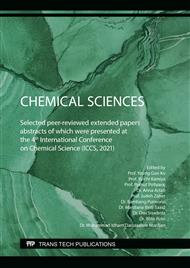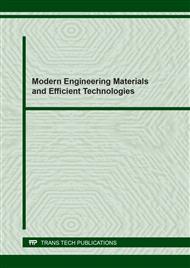[1]
A. Mareta, Studi pengolahan limbah cair di PT Pupuk Sriwidjaja Palembang, Internship Report of Environmental Engineering, Universitas Pertamina, Jakarta, (2019).
Google Scholar
[2]
M.R. Royan, M.H. Solim, M.B. Santanumurti, Ammonia-eliminating potential of Gracilaria sp. and zeolite: A preliminary study of the efficient ammonia eliminator in aquatic environment, IOP Conf. Ser.: Earth Environ. Sci. 236 (2019) 012002.
DOI: 10.1088/1755-1315/236/1/012002
Google Scholar
[3]
A.I. Alfarokhi, Pemanfaatan eceng gondok (Eichornia crassipes) sebagai tumbuhan fitoremediasi dalam proses pengolahan limbah tambak udang Vannamei, Undergraduate Thesis, Universitas Islam Indonesia, Yogyakarta, (2016).
DOI: 10.20885/jstl.vol12.iss1.art5
Google Scholar
[4]
D.S. Vidyawati, F. Herlina, Pengaruh firoremediasi enceng gondok (Eichornia crassipes) melalui pengenceran terhadap kualitas limbah cair industri tahu, LenteraBio: Berkala Ilmiah Biologi 8 (2019) 114–119.
DOI: 10.14710/bioma.23.2.84-90
Google Scholar
[5]
I. Sumantri, Sumarno, N. Afiati, Pengolahan limbah cair pupuk kadar amoniak tinggi dengan proses gabungan microalgae dan nitrifikasi-denitrifikasi autotrofik, Prosiding Seminar Nasional Sains dan Teknologi, 2010, pp. B35–B40.
DOI: 10.14710/reaktor.14.1.79-85
Google Scholar
[6]
D.H. Pieper, W. Reineke, Engineering bacteria for bioremediation, Curr. Opin. Biotechnol. 11 (2000) 262–270.
Google Scholar
[7]
D.J. Arp, L.A. Sayavedra-Soto, N.G. Hommes, Molecular biology and biochemistry of ammonia oxidation by Nitrosomonas europaea, Arch. Microbiol. 178 (2002) 250–255.
DOI: 10.1007/s00203-002-0452-0
Google Scholar
[8]
T.A. Nainggolan, S. Khotimah, M. Turnip, Bakteri pendegradasi amonia limbah cair karet Pontianak Kalimantan Barat, Protobiont 4 (2015) 69–76.
Google Scholar
[9]
I. Sabbah, K. Baransi, N. Massalha, A. Dawas, I. Saadi, A. Nejidat, Efficient ammonia removal from wastewater by a microbial biofilm in tuff-based intermittent biofilters, Ecol. Eng. 53 (2013) 354–360.
DOI: 10.1016/j.ecoleng.2012.12.075
Google Scholar
[10]
E. Nurisman, S. Syaiful, M. Faizal., S.P. Estuningsih, Studi eksperimental uji potensi isolat bakteri petrofilik dalam menurunkan kadar amoniak pada air limbah, Prosiding Seminar Nasional AVoER XII, 2020, 511–519.
Google Scholar
[11]
M.P. Ryan, J.T. Pembroke, Brevundimonas spp: Emerging global opportunistic pathogens, Virulence 9 (2018) 480–493.
DOI: 10.1080/21505594.2017.1419116
Google Scholar
[12]
B. Ji, W. Chen, L. Zhu, K. Yang, Isolation of aluminum–tolerant bacteria capable of nitrogen removal in activated sludge, Mar. Pollut. Bull. 106 (2016) 31–34.
DOI: 10.1016/j.marpolbul.2016.03.051
Google Scholar
[13]
T.S. Radniecki, E.G. Lauchnor, Chapter Nine - Investigating Nitrosomonas europaea stress biomarkers in batch, continuous culture, and biofilm reactors, in: M.G. Klotz, L.Y. Stein (Eds.), Research on Nitrification and Related Processes Part B, Academic Press, Cambridge, MA, 2011, p.217–244.
DOI: 10.1016/b978-0-12-386489-5.00009-9
Google Scholar
[14]
M.L. Shuler, F. Kargi, Bioprocess Engineering: Basic Concepts, 2nd ed., Prentice Hall Internationals, Englewood Cliffs, New Jersey, (2002).
Google Scholar
[15]
D.P. Yuniarti, R. Komala, S. Aziz, Pengaruh proses aerasi terhadap pengolahan limbah cair pabrik kelapa sawit di PTPN VII secara aerobic, Jurnal Redoks 4 (2019) 7–16.
DOI: 10.32734/jtk.v5i4.1552
Google Scholar
[16]
F. Febiyanto, Effects of temperature and aeration on the dissolved oxygen (DO) values in freshwater using simple water bath reactor: A brief report, Walisongo J. Chem. 3 (2020) 25–30.
DOI: 10.21580/wjc.v3i1.6108
Google Scholar
[17]
N.J.S. Desmet, S. Van Belleghem, P. Seuntjens, T.J. Bouma, K. Buis, P. Meire, Quantification of the impact of macrophytes on oxygen dynamics and nitrogen retention in a vegetated lowland river, Phys. Chem. Earth 36 (2011) 479–489.
DOI: 10.1016/j.pce.2008.06.002
Google Scholar
[18]
B. Yudono, S.P. Estuningsih, Bacteria exploration indigen as Microbial Enhanced Oil Recovery (MEOR) in old wells (Abandon well) in PT Pertamina UBEP Lemons Muara Enim, Prosiding Seminar Nasional AVoER V, 2013, p.254–259.
Google Scholar
[19]
A. Fumasoli, H. Burgmann, D.G. Weissbrodt, G.F. Wells, K. Beck, J. Mohn, E. Morgeronth, K.M. Udert, Growth of Nitrosococcus-related ammonia-oxidizing bacteria coincides with extremely low pH values in wastewater in high ammonia content, Environ. Sci. Technol. 51 (2017) 6857–6866.
DOI: 10.1021/acs.est.7b00392
Google Scholar
[20]
Y. Yosmaniar, H. Novita, E. Setiadi, Isolasi dan karakterisasi bakteri nitrifikasi dan denitrifikasi sebagai kandidat probiotik, Jurnal Riset Akuakultur 12 (2017) 369–376.
DOI: 10.15578/jra.12.4.2017.369-378
Google Scholar



